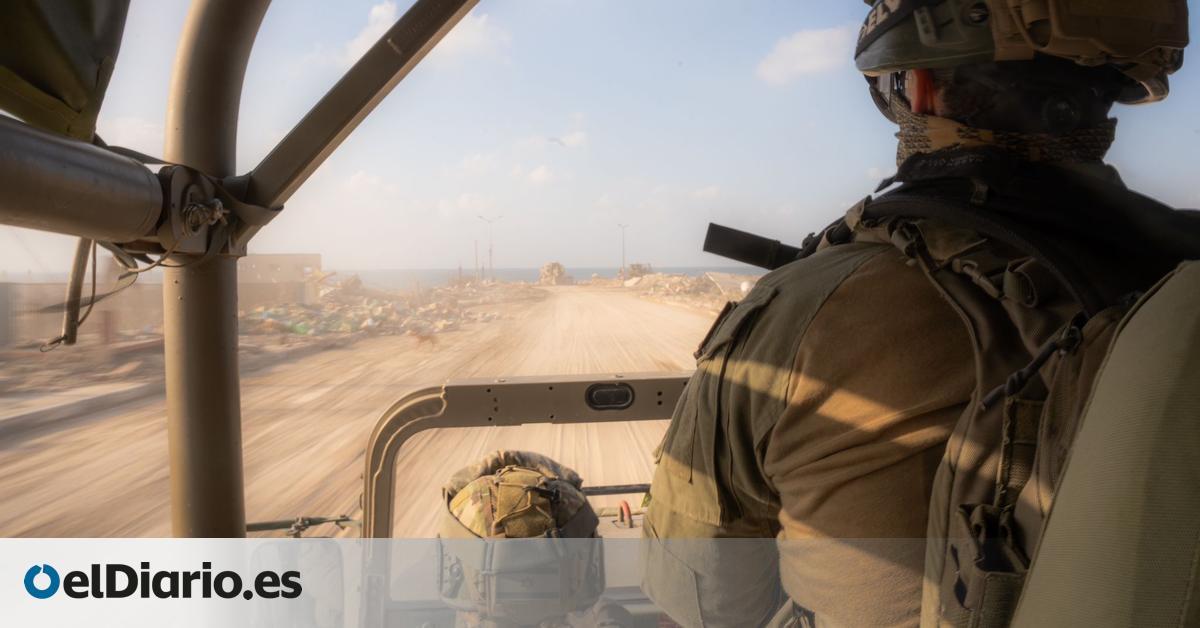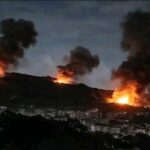
Israel is continuing its intense bombing campaign across northern and southern Gaza for the fourth day since the end of the truce with Hamas, killing hundreds of Palestinians on Sunday alone, according to local officials.
On Sunday night, the Israeli military also said it had expanded its ground operation to all of Gaza. “The IDF [Fuerzas de Defensa de Israel] They continue to expand their ground operation against Hamas centers throughout the Gaza Strip,” spokesman Rear Admiral Daniel Hagari told reporters in Tel Aviv. “The forces are coming face to face with the terrorists and killing them.”
This Monday, dozens of armored vehicles were seen entering the Gaza Strip from the south, near Khan Yunis, according to several witnesses reported to the AFP agency. Last week, the Israeli Army requested the evacuation of these areas. In addition, the armed forces have blocked what until now was the main evacuation route to the south, Salah al Din, which divides Khan Yunis in two, and have recommended the departure of civilians towards Rafah to the west, next to the sea.
Strip residents #Gaza،
The IDF acts forcefully against #agitation And terrorist organizations in the Gaza Strip, especially in the area #Khan_Younes.Here are several urgent instructions:
The fighting and military advance of the Defense Army in the Khan Yunis area do not allow the movement of civilians through the Salah al-Din axis in the sections north and east of the city… pic.twitter.com/fQOBR6fHsF
– Avichay Adraee (@AvichaiAdraee) December 4, 2023
The Army has indicated that it has attacked 200 Hamas targets in the last few hours. According to local authorities, more than 15,500 people have died from the bombings (6,600 of them are minors).
Previously, the Jabaliya refugee camp in the north of the country had been attacked on Sunday and, according to initial reports, dozens of people had been killed and at least one block of houses had been destroyed. Video footage shows people searching for bodies under the rubble.
Some 300 people were reportedly sheltering in the vicinity of the latest attack, in an area of countryside that has been the target of Israeli attacks repeatedly over the past month. It has not been possible to verify the exact number of victims.
Heavy shelling was also reported on Sunday in the southern city of Khan Younis, increasingly the target of Israeli attacks, as its army demanded a new evacuation of civilians from areas of the city, telling them to head south to Rafah, or to West. Clashes between Hamas and Israeli troops were reported about a mile outside the city on Sunday night.
Israeli government spokesman Eylon Levy said the army had attacked more than 400 targets over the weekend “including extensive airstrikes in the Khan Younis area” and had also killed Hamas militants and destroyed their infrastructure in Beit Lahiya, in the north.
Gaza residents had said on Sunday that they feared an Israeli ground offensive against southern areas was imminent. Tanks had cut the road between Khan Younis and Deir Al Balah in central Gaza, effectively dividing the Strip into three.
Ismael al Thawabteh, director general of the government’s media office in Gaza, told Al Jazeera that more than 700 Palestinians had been killed in a 24-hour period up to midday on Sunday. The Hamas-run Gaza Health Ministry later stated that 15,523 Palestinians had been killed since the start of the war, of whom 316 had died and 664 had been wounded “in the last few hours.” 70% of the dead are women and children.
There are an estimated 1.8 million internally displaced people, up from the previous figure of 1.7 million, according to the UN humanitarian agency OCHA. Footage shows Palestinians attempting to leave parts of Khan Younis in response to Israeli evacuation demands.
On Saturday night, Israeli Prime Minister Benjamin Netanyahu said at a press conference that he had ordered the military to attack Gaza with “increasing force” and repeated that his country’s goal is to eliminate Hamas as a political and military force. in the bombed strip.
“Citizens of Israel, we are in the middle of a difficult and bitter war, but there is no more just war. “It is a war for our home,” Netanyahu said. “We still have a difficult war ahead of us, but in the end we will be victorious.”
Israel’s revised plan is expected to include intensified bombing of evacuated areas as a prelude to a ground operation in the south, in which it is expected to try to take Khan Younis, where Hamas leadership is believed to be based. His army also wants to consolidate control in the north.
The Israel Defense Forces on Friday published a map dividing Gaza into hundreds of small numbered districts. Israel has begun asking civilians to evacuate certain areas before military operations begin, dropping leaflets and sending mobile phone alerts.
Humanitarian organizations and some politicians have harshly condemned Israel for its piecemeal evacuation plan, which they say leaves Palestinians with fewer and fewer places to flee to, while Gaza’s infrastructure is on the brink of collapse.
The prosecutor of the International Criminal Court (ICC) called on Israel to respect international rules of war and said he was accelerating his investigation into Israeli settler violence against Palestinians in the occupied West Bank.
Filippo Grandi, UN High Commissioner for Refugees, told the BBC that Palestinians in Gaza are being “pressed ever more into a narrow corner of what is already a very narrow territory” by the renewed Israeli offensive.
UNRWA, the UN aid agency for Palestinian refugees, stated that Palestinians in Gaza are at risk of dying from infectious diseases as sanitation is under pressure. There has been an outbreak of hepatitis A at a school run by the agency, said Thomas White, its director in Gaza.
On Sunday, US national security spokesman John Kirby said the White House believed Israel had “been receptive to our messages of trying to minimize civilian casualties” and praised the localized evacuation plan.
Ron Dermer, Israeli Minister of Strategic Affairs, insisted on US television network ABC that the military’s efforts to minimize civilian casualties were unprecedented. “If we wanted to do it quickly,” he said, “we would harm many more civilians.”
Emmanuel Macron, the French president, at a news conference in Dubai, said he believed Israel risked triggering a decade-long war.
“What is the total destruction of Hamas and does anyone believe it is possible? If it is, the war will last 10 years,” Macron said on Saturday. “I think we are at a point where the Israeli authorities are going to have to define more precisely their objective and the desired end state.”
The Israeli military announced that it had found 800 tunnel entrances in Gaza since the start of ground operations in late October, and that it had destroyed 500 of them with explosives, blocks and other methods.
Hamas has for many years built a sophisticated underground network to protect its forces from Israeli bombing and its leaders are believed to operate underground.
The IDF claims that many of the tunnels are located “near or inside civilian buildings and structures, such as schools, daycare centers, mosques, and playgrounds,” and that in some cases weapons were stored in the shafts.
Late Sunday, the IDF also reported that it had killed Hamas commander Haitham Khuwajari in an airstrike. Khuwajari was responsible for “numerous acts of terror” against Israel and, under his command, “Hamas terrorists carried out incursions into Israeli territory on October 7.”
Separately, Israeli settlers killed a man while attacking two Palestinian villages in the occupied West Bank late Saturday, Palestinian authorities said. A 38-year-old man was shot in the chest in Qarawat Bani Hassan in the northern West Bank, the Palestinian ambulance service said.
Translation of Javier Biosca
Source: www.eldiario.es
